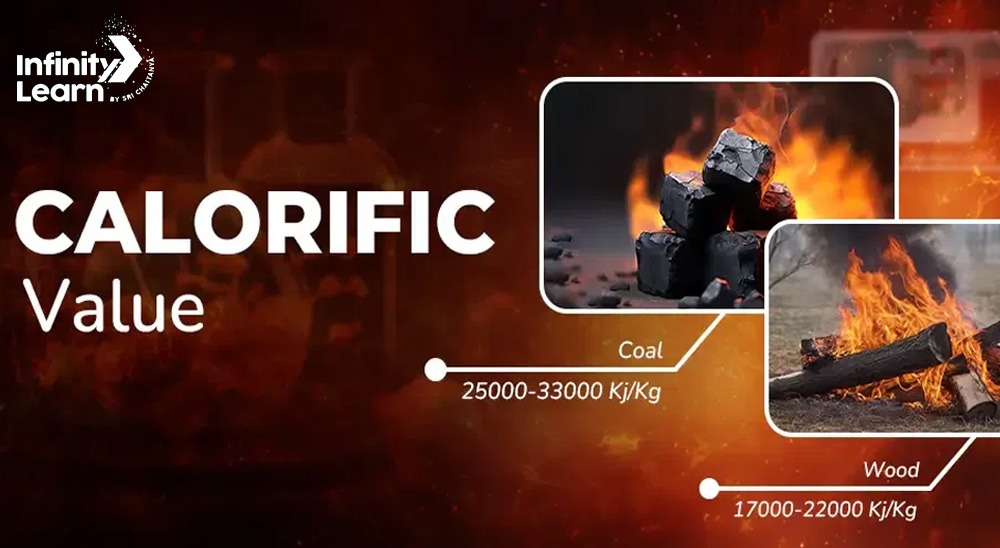Table of Contents
Calorific value is defined as the energetic content of a substance. It is the amount of heat that is produced after combustion of a substance. Calorific value can also be expressed as gross calorific value or high heating value. It is important in the energy and fuel industry as it helps determine the efficiency of the fuel.

What are the types of calorific values?
There are generally two types of calorific value: high calorific value and low calorific value.
Let us discuss them, in brief, going further.
- High Calorific Value (HCV) or Gross Calorific Value (GCV)
This value indicates the total amount of heat released after the complete combustion of fuel.
- It contains the heat of condensation of water vapor.
- Essentially, it measures all the energy released during combustion.
- It accounts for the energy required to vaporize the water produced during burning.
- Lower Calorific Value (LCV) or Net Calorific Value (NCV)
This is the net amount of heat generated when a fuel is burned, less the latent heat of water vaporisation.
- It is a usable energy, without considering the energy used to vaporize water.
- This means that it assumes the water remains vapor.
- Used in cases where the energy from water vapor cannot be recovered.
- For example in engines and boilers.
Also Check: Calorific Value Of Fats
Efficiency of Calorific Value
The calorific value is an important factor in determining a fuel’s efficiency and acceptability for various uses. The calorific value, whether Higher Calorific Value (HCV) or Lower
Calorific Value (LCV), provides a precise estimate of the energy received from a given fuel’s full combustion.
It is more effective when heat from water vapor is recovered, such as in industrial processes that allow condensation of water vapor. Fuels with this measure have more energy potential.
When water vapor is not condensed, such as in internal combustion engines and power plants, LCV makes more sense. Since LCV excludes the energy lost through evaporation, it is more realistic.
How to Calculate Calorific Value?
Calorific value can be calculated either experimentally or by using formulas that estimate the energy content of a fuel based on its composition. Here’s a brief overview of both methods:
Experimental Method
The calorific value is determined using a Bomb Calorimeter. It is a device designed to measure the heat of combustion of a fuel. The procedure is mentioned below:
- A known amount of fuel is burned in the calorimeter.
- The heat produced by the combustion is transferred to a known quantity of water surrounding the combustion chamber.
- The rise in the water’s temperature is measured, and using this temperature rise, the calorific value is calculated with the formula:
- Calorific Value (CV)=mass of water × specific heat of water × temperature rise/mass of fuel burned.
- Hence, this gives the Higher Calorific Value (HCV) directly.
Theoretical Method
For estimating calorific value, Dulong’s formula is commonly used. It is based on the chemical composition (carbon, hydrogen, sulfur, etc.) of the fuel:
CV = (8080×C)+(34500×H)+(2240×S)−(6240×O)
Where C, H, S, and O represent the percentage of carbon, hydrogen, sulfur, and oxygen in the fuel.
Both methods provide an understanding of how much energy a fuel will produce, helping industries optimize fuel use and efficiency.
The calorific value of food
The calorific value of food refers to how much energy it contains when digested and metabolised by the body. It is expressed in kilocalories (kcal) or kilojoules (kJ). Here are the key components of the calorific value of the food.
- Carbohydrates: Provide 4 kcal per gm
- Proteins: Provide 4 kcal per gm
- Fats: Provide 9 kcal per gm
- Alcohol: Provides 7 kcal per gm
Significance of Calorific Value of Food
Let us understand the significance of the calorific value of the food.
- Helps you determine the energy content of various foods.
- Used to monitor nutritional intake and body weight.
- It helps in nutritional labeling on food products to inform consumers about energy intake.
- Helpful in diet planning fitness and weight management.
- Keeping track of calorific intake can help maintain a balanced diet, preventing excessive intake that may lead to weight gain.
FAQs on Calorific Value
What is calorific value?
Calorific value is defined as the amount of energy released when a certain quantity of fuel or food is completely burned. It is measured in units such as joules, calories, or BTUs.
What are the types of calorific value?
There are two types: Higher Calorific Value (HCV) or Gross Calorific Value (GCV) and Lower Calorific Value (LCV) or Net Calorific Value (NCV).
How is calorific value measured?
It is measured using a bomb calorimeter in a controlled environment or estimated using formulas based on the fuel or food's composition.
How does the calorific value of food affect diet?
It helps in calculating the energy provided by foods, which is essential for managing dietary intake and body weight.
Which fuel has the highest calorific value?
Hydrogen has the highest calorific value among fuels, approximately 150 kJ/g









